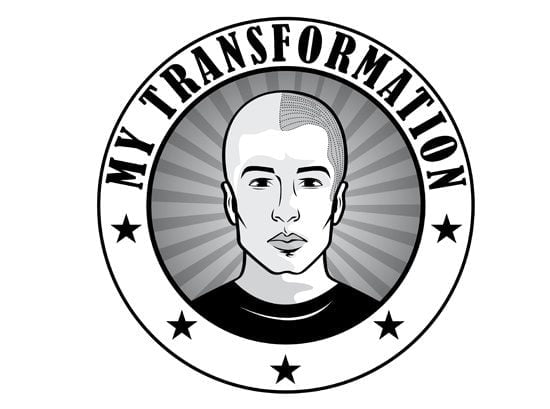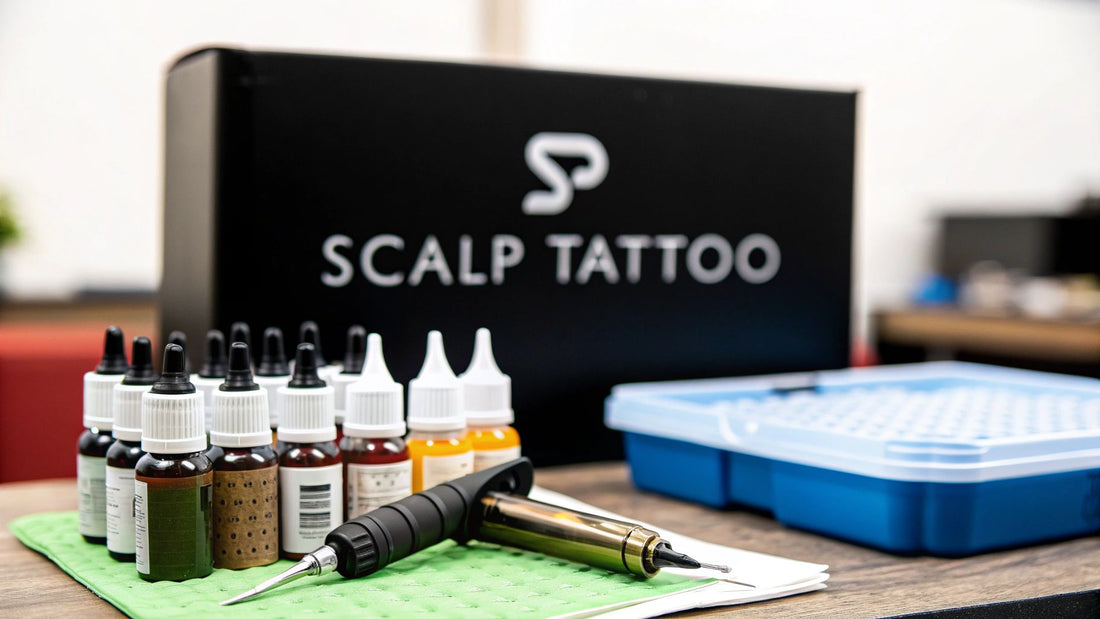
Your Guide to the Tattoo Scalp Procedure
Share
When you hear the term "tattoo scalp," what comes to mind? It's actually the everyday name for a highly advanced cosmetic procedure called Scalp Micropigmentation, or SMP for short. This is a non-invasive treatment that uses tiny microneedles to place pigment into the scalp, cleverly creating the illusion of thousands of little hair follicles.
The result? It can either masterfully mimic the look of a full, freshly buzzed haircut or add the appearance of thickness to areas where your hair is starting to thin.
Unpacking the Scalp Tattoo Technique
While people often call it a "tattoo," scalp micropigmentation is a world away from traditional body art. It's less about bold lines and more about a delicate, artistic technique, almost like pointillism for your head. The aim isn't to draw anything on; instead, it's about building up layers of countless tiny dots that, together, create a completely natural illusion of hair.
This highly specialised process is precisely what sets SMP apart from a standard tattoo parlour. Every single element, from the equipment right down to the artist's technique, is specifically designed to replicate the look of real hair.
Key Differences from Traditional Tattoos
Getting your head around these differences is key to understanding the skill and impressive results of SMP. The entire procedure is meticulously planned to avoid the harsh, fake look that you'd get if you tried this with a regular tattoo gun.
Here’s what makes a proper scalp tattoo treatment so unique:
- Specialised Pigment: SMP relies on carbon-based pigments formulated to match natural hair colours. Unlike standard tattoo inks that can fade to strange blue or green shades over the years, these pigments are designed to simply soften into a lighter version of the original colour.
- Finer Needles: The needles used are much smaller—often called microneedles. This allows the technician to create incredibly fine dots that perfectly mimic the size of an individual hair follicle.
- Shallow Application Depth: Pigment is carefully placed into the upper layer of the scalp's skin (the dermis), which is much shallower than in body art. This crucial step stops the dots from blurring or spreading over time, keeping the "follicles" looking sharp and defined.
- Expert Technique: A properly trained SMP artist uses a very specific dotting and layering method across several sessions. This isn't a one-and-done job; it’s about slowly building up density to create a seamless, three-dimensional effect that looks real from every angle.
Scalp Micropigmentation is a highly nuanced craft. It's the blend of technical precision and artistic vision that turns simple dots of pigment into a life-changing illusion of a full head of hair.
As a modern solution for hair loss, scalp tattooing fits perfectly under the banner of non-surgical hair restoration, providing a dependable and effective alternative for many people.
The procedure has become incredibly popular here in Australia, as more men and women look for practical, non-invasive ways to tackle hair thinning and baldness. Clinics in major hubs like Sydney and Melbourne are seeing more and more clients who either prefer SMP to surgery or need it to camouflage scars from previous procedures. This trend really shows a move towards cosmetic treatments that give natural-looking results without the hassle of significant downtime.
For a deeper dive into the specifics, you can learn more about what scalp micropigmentation is in our detailed guide.
Your Step-By-Step Scalp Micropigmentation Journey
Thinking about getting a scalp tattoo is a big decision, so knowing exactly what's involved from start to finish can make the whole thing feel a lot less daunting. It’s best to see it as a carefully planned journey, not just a one-off appointment. Each stage is designed to build on the last, all working towards that incredibly realistic finish.
The whole process is a partnership. It kicks off with your vision and ends with a look that brings back your confidence, with you and your technician working together every step of the way.
The Initial Consultation: Your Personalised Blueprint
Your journey starts with a thorough consultation. Honestly, this first meeting is probably the most important part of the entire process because it sets the stage for everything that follows. You'll sit down with an experienced technician to chat about what you're hoping to achieve.
They’ll take a close look at a few key things:
- Your specific pattern of hair loss to figure out which areas need more density.
- Your skin tone and the colour of your existing hair so they can mix a custom pigment that blends in seamlessly.
- The kind of hairline you want, whether that’s a sharp, defined edge or something softer and more natural-looking.
This is anything but a one-size-fits-all deal. The technician collaborates with you to design a hairline that really suits your face and age, making sure the final result is both flattering and believable. It's your chance to ask all your questions and get a really clear idea of what’s possible.
The consultation is where the art meets the science. It’s all about mapping out a strategy tailored specifically to you, ensuring the scalp tattoo enhances your features naturally.
Your First Treatment Session
Once your personalised plan is locked in, it’s time for your first treatment session. This is where the magic begins, as the first layer of pigment goes down to create the foundation of your new look. A typical session lasts between two and four hours, depending on how large the treatment area is.
Your artist will meticulously place thousands of tiny pigment dots across your scalp. Most people describe the feeling as a slight irritation rather than sharp pain – the average client puts it at a 2 to 4 on a 10-point pain scale. This session establishes the basic shape and initial coverage. For a full rundown on what to do beforehand, take a look at our guide on how to prepare for scalp micropigmentation treatment.
This image shows the basic idea of how a professional applies the pigment during a session.
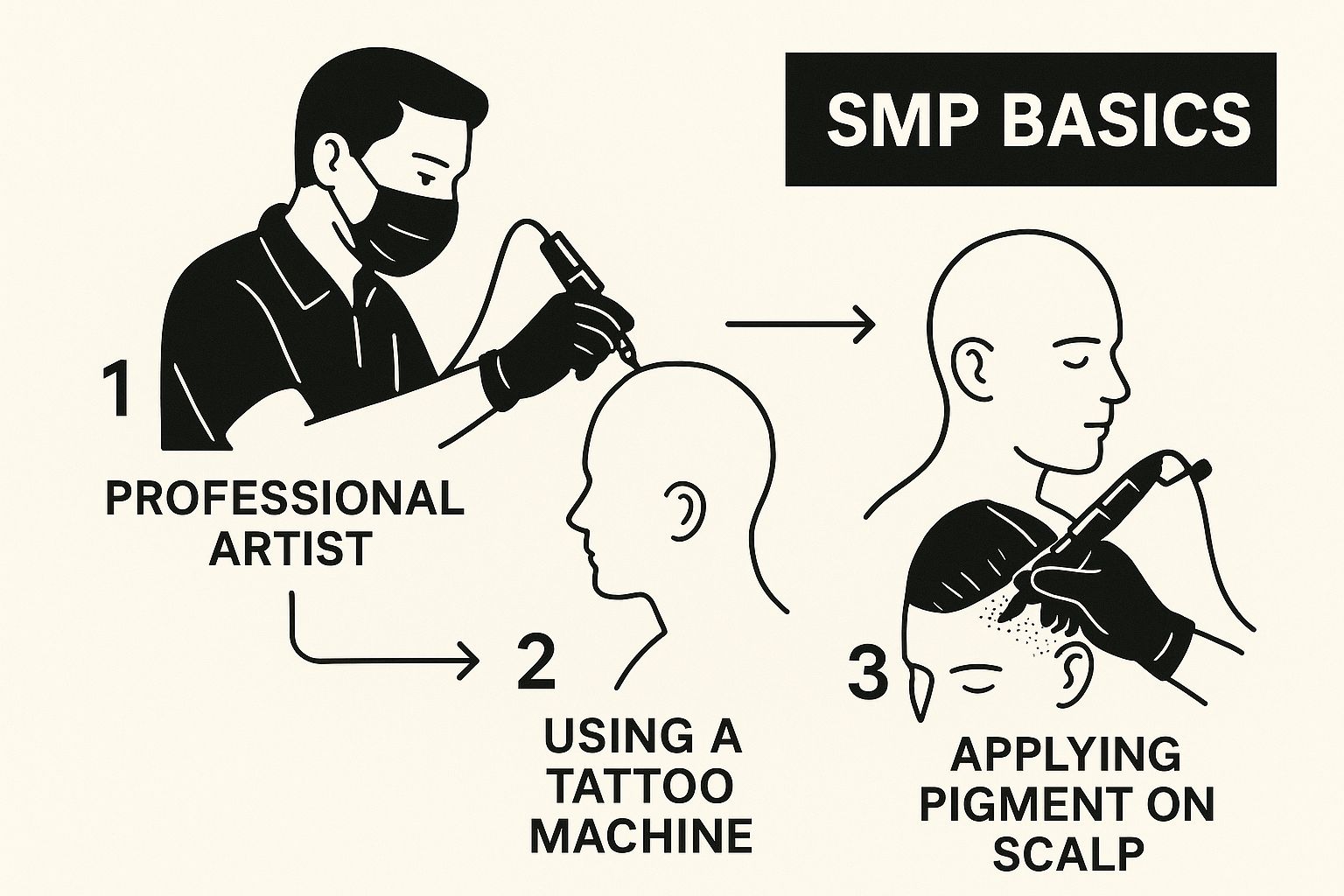
It really highlights the precision involved, as the technician uses a specialised machine to create impressions that look just like real hair follicles.
Building Density Through Multiple Sessions
One of the biggest misconceptions about scalp tattoos is that it’s a one-and-done procedure. To get that truly realistic, three-dimensional look, you’ll actually need two to four appointments, usually spaced about 10 to 14 days apart.
This multi-session approach isn’t just for fun; it's absolutely crucial for a few reasons:
- Layering for Realism: Each session adds another layer of pigment, gradually building up the density. This layering technique is what creates the illusion of depth and stops it from looking flat or like a "helmet," which can happen with a single, heavy application.
- Strategic Healing: The gap between sessions gives your scalp time to heal and the pigment a chance to settle. It also lets the technician see how your skin is taking the pigment, allowing them to make smart adjustments in the next session.
- Perfecting the Shade: The artist often starts with a slightly lighter shade in the first session. In the follow-up appointments, they can tweak the tones, adding darker shades where needed to create a perfectly blended, textured finish.
Think of it like an artist painting a portrait. The first session is the initial sketch, the second adds the base colours, and the final sessions bring in the shading and fine details that make it come alive. It's this methodical process that ensures your scalp tattoo is indistinguishable from a genuine, full head of hair.
Is a Scalp Tattoo Right for You?
Jumping into a scalp tattoo is a big decision, so it's smart to figure out if it’s genuinely the right move for you. Scalp micropigmentation isn't some magic bullet for everyone; its success really hinges on your specific type of hair loss, what you want to achieve, and the current health of your scalp.
Think of this as a quick self-check to see if you're a good match for the procedure. We'll walk through the common situations where SMP works wonders and also flag the scenarios where it might not be the best path forward.
Who Is a Great Candidate for SMP?
Scalp micropigmentation delivers incredible, confidence-boosting results for a wide variety of people. If any of the descriptions below sound like you, this treatment could be a brilliant option.
-
Men with Pattern Baldness: If you're dealing with a receding hairline or that classic bald spot on the crown, SMP can expertly mimic the look of a sharp, full buzz cut. It’s the perfect solution for guys who are ready to own a clean-shaven style.
-
Anyone with Thinning Hair: This is a big one for both men and women. When your hair is thinning all over, the pigment can be subtly applied between your existing strands. This instantly reduces the stark contrast between your scalp and hair, creating a really convincing illusion of thickness and density.
-
Hiding Scars: SMP is an absolute game-changer for covering up scars. Whether it’s from an old injury or a hair transplant surgery (like FUT or FUE), a skilled technician can blend pigment into the scar tissue and surrounding hair, making it practically disappear.
-
People with Alopecia: For certain types of hair loss, like alopecia areata, SMP can be an incredibly effective tool. It’s used to fill in the patchy spots, giving the entire scalp a more even and complete look. We dive deeper into this in our article on scalp micropigmentation for alopecia.
The real power of a scalp tattoo is its versatility. It can rebuild a hairline from scratch, create visual density where hair is thinning, or masterfully hide imperfections, helping you feel whole and confident again.
When a Scalp Tattoo Might Not Be the Best Fit
Just as it's important to know who SMP is for, it's crucial to understand when it's not the answer. Some health conditions or personal expectations mean you might not get the results you're hoping for.
You'll always need to have a proper chat with a professional, but here are a few things that could rule you out:
-
Active Scalp Conditions: If you're currently dealing with a flare-up of severe psoriasis, dermatitis, or folliculitis on your scalp, the procedure can't go ahead. These conditions need to be under control and dormant before it's safe to apply any pigment.
-
Tendency for Keloid Scarring: People who are prone to keloids (thick, raised scars) are usually advised against SMP. The tiny punctures from the needle, as minimal as they are, could potentially trigger a keloid to form.
-
Unrealistic Expectations: It’s vital to remember that SMP is a 2D illusion of hair follicles. It looks fantastic, but it doesn't actually grow hair or add any real texture. You have to be on board with the look of a very short buzz cut or the appearance of thicker hair, not the feel of it.
As you weigh your options, it's always a good idea to look at the whole picture. Consider all the different ways to manage hair loss, from medical treatments to various natural remedies for hair loss. At the end of the day, the best decision is an informed one, based on a clear understanding of your own situation and what each option can realistically deliver.
Understanding the Costs of a Tattoo Scalp Treatment
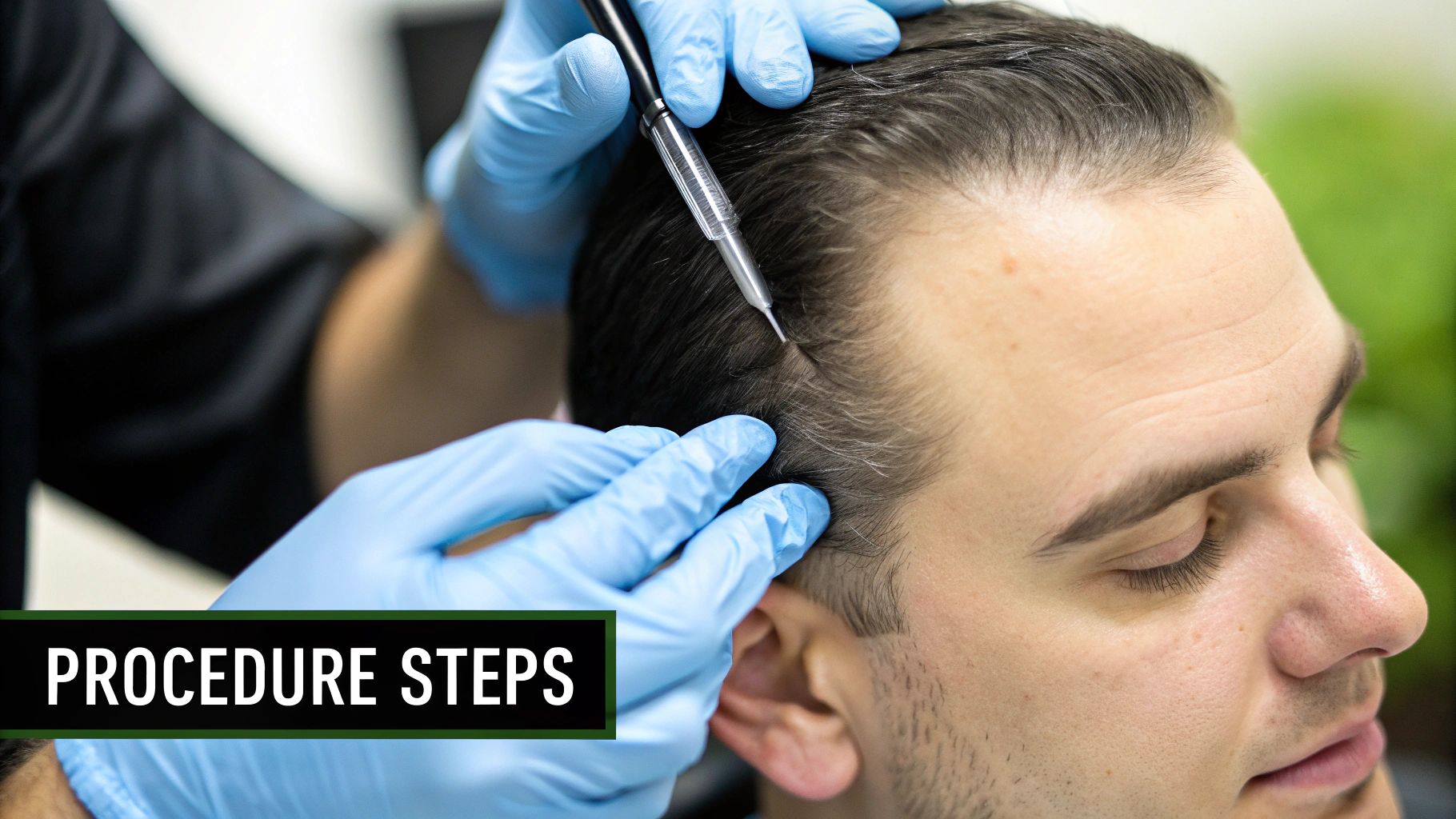
Let's get straight to the big question everyone has: "How much is a tattoo scalp treatment actually going to cost me?" It’s a fair question. This is a real investment in your appearance and confidence, so you need to understand where your money is going.
The truth is, there's no single price tag. Think of it like getting a custom suit made. The final cost depends on the material, the complexity of the design, and how much tailoring is needed. In the same way, the price of your scalp micropigmentation is tailored specifically to you.
Key Factors That Determine Your Price
When a clinic gives you a quote, they aren’t just picking a number at random. They’re carefully calculating the time, skill, and resources needed to give you a result that looks completely natural.
Here’s a look at what they’re sizing up:
- Extent of Your Hair Loss: This is the number one factor. We often use the Norwood Scale to classify the stage of male pattern baldness. Treating a slightly receding hairline (Norwood 2) is a much smaller job than recreating a full buzz-cut look for someone with significant hair loss (Norwood 6 or 7).
- Size of the Treatment Area: This goes hand-in-hand with the point above. The more scalp we need to cover—whether it’s the crown, hairline, or filling in general thinning—the more time it will take.
- Desired Density and Complexity: Are you just trying to add some subtle shading to make your existing hair look thicker? Or are we building a brand-new, crisp hairline from scratch? The second option is far more detailed and requires more sessions to build up those convincing layers of pigment.
- Scar Camouflage: Working on scar tissue, especially from old hair transplants, is a specialist skill. It takes a delicate touch and a lot of precision to get the pigment to blend seamlessly, which often adds to the overall cost.
Understanding these elements helps you see why the price is what it is. You're not just buying a procedure; you're investing in a bespoke solution designed to match your unique pattern of hair loss perfectly.
Estimated Scalp Micropigmentation Costs in Australia
To give you a ballpark idea, the cost for scalp micropigmentation in Australia varies quite a bit depending on the factors we've just covered. A complete treatment is usually broken down into 2-4 sessions to build the density and detail required for a flawless finish.
Here’s a quick look at what you might expect to pay for different types of SMP work.
Estimated Scalp Micropigmentation Costs in Australia
| Treatment Type | Typical Price Range (AUD) |
|---|---|
| Full Head Treatment (Norwood 5-7) | $2,600 - $3,500+ |
| Adding Density to Thinning Hair | $1,800 - $2,600 |
| Hairline Restoration (Norwood 2-3) | $1,500 - $2,800 |
| Scar Camouflage (FUE/FUT scars) | $1,900 - $2,500 |
Keep in mind that these are estimates. For a more in-depth look at what goes into these figures, check out this breakdown of scalp micropigmentation costs.
Why Do Clinic Prices Differ?
You've probably noticed that quotes can vary from one clinic to another. So, what’s the deal? More often than not, you're paying for experience. A higher price usually reflects a technician’s advanced training, years of hands-on work, and a portfolio full of incredible results.
Other things like the clinic’s location and the quality of the pigments and equipment also play a part. Ultimately, choosing a reputable artist with proven expertise is the best way to ensure your tattoo scalp looks amazing for years to come. It’s an investment you won’t regret.
Long-Term Care for Your Scalp Tattoo
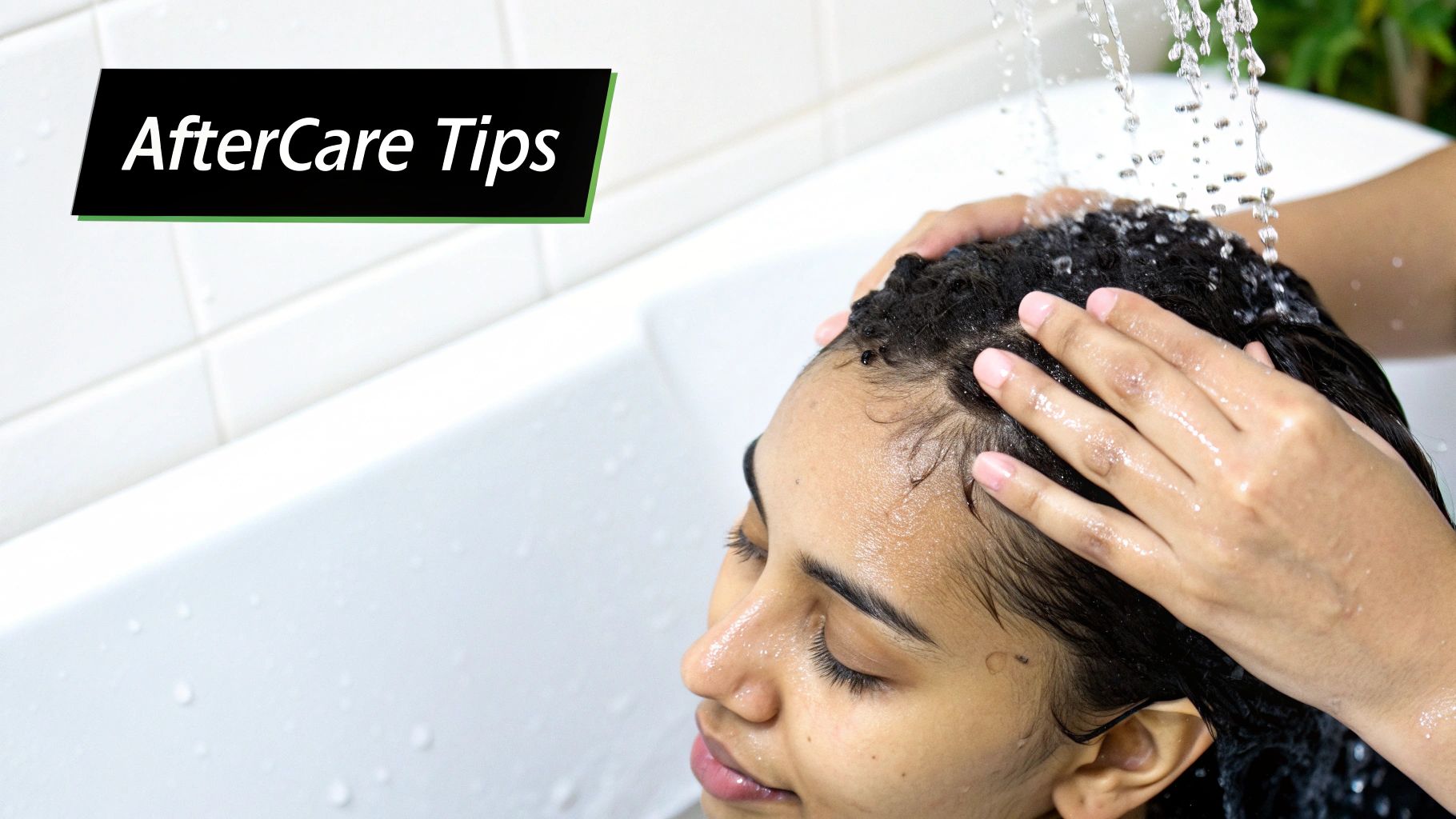
Think of your tattoo scalp procedure as a long-term investment in your confidence. And just like any great investment, it needs a little upkeep to keep it looking sharp for years to come. The good news is, the maintenance is surprisingly simple.
It all starts the moment you walk out of the clinic. The first few days are crucial for locking in those results and ensuring the pigment heals perfectly.
Immediate Aftercare: The First Four Days
The initial healing period is where the magic really sets. For the first four days after each session, you'll need to be extra careful. This is all about letting the pigment settle into the skin without any disturbances.
During this critical window, these rules are non-negotiable:
- Keep it Dry: Don't wash your head, get caught in a downpour, or let the shower spray hit your scalp.
- No Heavy Sweating: That means taking a short break from intense gym sessions, saunas, and steam rooms. Sweat can actually push the pigment out before it has a chance to set.
- Stay in the Shade: If you have to be outside, wear a loose-fitting hat. Direct sun on healing skin is a big no-no and can interfere with the pigment.
- Hands Off: Your scalp might get a little itchy as it heals—that’s normal. But you absolutely cannot scratch, rub, or pick at the area.
Following these steps ensures every tiny follicle replication heals crisply, which is the key to that hyper-realistic look. For a deeper dive, check out our 5 top tips to care for your scalp after SMP.
Long-Term Strategies for a Lasting Look
Once you’re past those first few days, looking after your SMP becomes about simple, daily habits. It's less about strict rules and more about smart routines that will keep your scalp tattoo looking fresh.
The two biggest enemies of your SMP are the sun and dry skin. Protecting your scalp from these two things is the most important part of your long-term care plan.
Sun Protection is Non-Negotiable
UV rays are the number one reason pigment fades. Think of sunscreen as your SMP’s best mate.
Always apply a high-SPF sunscreen (SPF 30+ or higher) to your scalp when you know you'll be in the sun. Pro tip: look for a matte-finish sunscreen. It works wonders to reduce shine for a more natural, buzzed-cut appearance.
Moisturise Your Scalp Daily
Healthy, hydrated skin holds pigment far better than dry, flaky skin. A daily moisturising routine prevents the pigment from looking dull and keeps your scalp in top condition. Just a light, non-greasy moisturiser once a day is all it takes.
Setting Realistic Expectations for Touch-Ups
Even with the best care in the world, a tattoo scalp is considered semi-permanent. The pigment is actually designed to soften and lighten over time. This is a good thing—it ensures the look remains natural as your own features and hair colour change with age.
Here in Australia, you can expect your SMP to look great for four to six years before you might want a touch-up. Of course, this depends on your skin, your lifestyle, and how well you follow the aftercare. Someone who spends a lot of time in the sun without a hat or sunscreen, for example, might need a refresh closer to the two-year mark.
A touch-up session is straightforward. Your artist simply adds a fresh layer of density and colour, bringing your SMP right back to its original glory. It’s like hitting the reset button, getting it looking brand new all over again.
Common Questions About Scalp Tattoos Answered
https://www.youtube.com/embed/b3Ut_x7i9X0
Even after getting your head around the process, the costs, and the aftercare, it’s completely normal to have a few more questions rattling around before you commit to a tattoo scalp procedure. This is a big decision, and feeling 100% confident is the only way to move forward.
We’ve pulled together some of the most common queries we hear from clients and laid out some clear, direct answers. The goal here is to iron out any final uncertainties so you have everything you need to decide if scalp micropigmentation is the right move for you.
Does Getting a Tattoo on Your Scalp Hurt?
This is easily the number one question we get asked, and the answer is usually a relief. The vast majority of our clients wouldn't describe the sensation as painful at all. Most people say it feels more like a minor irritation or a light, continuous tapping on the scalp.
If you were to put it on a scale of one to ten, most people rate the discomfort somewhere between a 2 and a 4. That's a world away from the intensity of a traditional body art tattoo. The main reason for this difference is that the specialised microneedles used for SMP barely break the surface, only penetrating the upper layers of the skin—much shallower than a standard tattoo needle.
To make sure you're as comfortable as possible, clinics will apply a topical numbing cream to your scalp before the session kicks off. While some spots, like around the temples and the frontal hairline, can be a little more sensitive, the feeling is temporary and most people find it very easy to tolerate.
Can Scalp Micropigmentation Damage Existing Hair?
This is another huge concern, especially for those looking to add density to thinning hair rather than treating a fully bald scalp. The answer is a definite no. When carried out by a skilled and qualified technician, scalp micropigmentation is a completely safe procedure that won't harm your existing hair follicles or get in the way of future hair growth.
Think of it this way: the pigment is carefully placed into the epidermis, which is the uppermost layer of your skin. Your hair follicles, on the other hand, live much deeper down in the dermal layer. The SMP needle never even comes close to that depth, meaning your natural hair is left completely untouched.
In fact, there's even some evidence to suggest the procedure might have a slight positive effect. The tiny punctures created during the session can boost blood flow to the scalp, a process sometimes called "collagen induction therapy," which works on a similar principle to microneedling. While that's not the main goal of SMP, it's good to know it certainly won't cause any harm.
The key takeaway is that a properly done scalp tattoo works with your existing hair, not against it. It's a cosmetic enhancement on the skin's surface that doesn’t interfere with the biology of your hair follicles.
What Happens If My Hair Turns Grey?
This is a brilliant and very practical question. It shows you're thinking long-term, and so is any good SMP artist. A skilled technician plans for this exact scenario right from the very beginning.
They don’t just use a harsh, solid black ink that would look completely fake down the track. Instead, they work with specialised, carbon-based pigments that are carefully diluted to create a whole spectrum of grey-scale tones. This custom-mixed shade is matched not only to your current hair colour but also to your skin's undertones for a seamless look.
So, as your natural hair starts to grey, the softened, grey-toned SMP pigment blends right in. The result isn't a jarring contrast but a subtle, shadowy base that looks completely natural as part of a greying buzz cut. It just adds a background of density that continues to look authentic as you age.
On top of that, touch-up sessions, which are usually needed every four to six years, are the perfect opportunity to make any necessary tweaks. During a touch-up, your artist can recalibrate the pigment shade to maintain a perfect blend with your changing hair colour, making sure your SMP ages as gracefully as you do.
Is It Possible to Remove a Scalp Tattoo?
Yes, absolutely. While the aim is always a result you’ll love for years to come, it’s reassuring to know that scalp micropigmentation isn't a life sentence. If you ever change your mind, SMP can be removed effectively with specialised laser treatments.
The good news is that removing SMP is often more straightforward than removing a traditional tattoo.
- Shallower Pigment Depth: Because the pigment is placed so close to the skin's surface, the laser can break it down more easily.
- Fewer Sessions Needed: As a result, SMP removal usually requires fewer laser sessions than body art tattoos, making the whole process quicker.
The procedure uses what’s called a Q-switched laser. It sends out powerful pulses of light that shatter the pigment particles into tiny fragments. Your body’s immune system then does the cleanup work, naturally flushing these fragments away over the following weeks.
Of course, knowing it's removable just highlights how important it is to do your homework upfront. Choosing a highly reputable, experienced, and skilled SMP artist from the start is the best way to ensure you get a fantastic result you’ll be proud of, so you never have to think about removal. It really does pay to invest in quality and expertise from day one.
At My Transformation, we are dedicated to helping you find the perfect solution for your hair loss. Michael's passion is to help every client achieve a look that restores their confidence. To start your own journey and see if scalp micropigmentation is right for you, explore our services at https://www.mytransformation.com.au.
